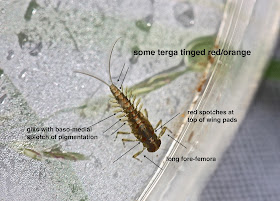Friday, July 27, 2012
Acentrella nadineae: Whence the Variations in Colors and Patterns?
The very first A. nadineae small minnow mayfly I found, I found last year on June 23 in the Doyles River at Doylesville (off Blufton Road). This one.
Today I returned to that site and found some again -- one was fully mature with black wing pads.
But it was the nymph in the photo at the top of the page that really drew my attention because of the light stripe that runs down the dorsum. Some more photos.
This is an A. nadineae pattern that I've seen only one time before -- last year on July 2 at the Lynch River.
And note, as well, the markedly greenish body color on that Lynch River nymph.
Note how different this nymph appears than one of the nymphs that I found at the North Fork of the Moormans just a few weeks ago on July 6.
I assure you that all of the nymphs in the photos above are A. nadineae small minnow mayflies: all have the key features we use for this ID. Those features are: 1) at least some of the terga are tinged red/orange; 2) the gills have a distinct "baso-medial" (extends from the base of the gill through the middle of the gill) splotch of gray pigmentation; 3) there are orange/red dots at the tops of the wing pads (though these are indistinct on mature nymphs); and 4) the fore femora are long, slightly longer than the fore tibiae and tarsi combined. Let's have another look at those features.
________________
Why don't all A. nadineae nymphs look the same? Clearly, part of this has to do with the level of maturity. All mayfly and stonefly nymphs, as we know, darken as they mature, and the orange/red markings on mature A. nadineae nymphs are harder to see.
But why are some fairly green while others are orange? Why do some seem to have a pale stripe down the middle? Why are the orange/red markings more pronounced on nymphs in one stream than they are on nymphs in another. On that point, by the way, have a look at the A. nadineae nymph that I found in Pennsylvania last week.
Red and orange dots and stripes and splotches on the terga, the thorax, the wing pads -- even the head!
I can't really answer my questions, but we do well to remember that colors and patterns do vary by stream, and that we always need to rely on morphology to determine species identification. Surely habitat -- types of vegetation in the water, types of rocks in the substrate, water chemistry -- accounts for some of these variations. And "camouflage" is always a relevant factor. Nymphs do evolve different colors and patterns for their own protection.
Whatever the explanation, or explanations, for the variations we find -- these are some of the loveliest
small minnow mayfly nymphs we see in our streams in the course of the year.
(Two of the nymphs from this morning huddle together and pose for a picture.)












No comments:
Post a Comment